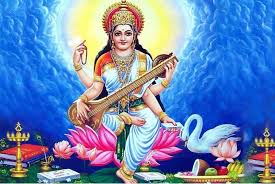 Sarasvati is a goddess of primary importance. She is accepted by Hindus as the goddess of learning, the arts, and scholarship. However, Sarasvati’s nature is far more complex and her mythology more interesting than is widely known.
Sarasvati is a goddess of primary importance. She is accepted by Hindus as the goddess of learning, the arts, and scholarship. However, Sarasvati’s nature is far more complex and her mythology more interesting than is widely known.
Sarasvati, whose name means “flowing” and “watery,” has been associated with an ancient river that was quite important in the Vedic period but eventually dried up because of a desertification that was occurring in the region. During the early Vedic period Sarasvati was associated with Agni, as one of the three flames of his fiery tongue (along with Ila and Bharati) or as his wife. In the multiple traditions reflected in the earliest Vedic hymns, Sarasvati next became the partner of Indra and then the Asvins, the twin physicians of the devas (gods). Sarasvati healed with her purifying waters, and her banks were particularly sacred for the Brahmanical animal sacrifices of that period. Ram and ewe were her favorite offering. In a time of intertribal warfare she granted absolution from the worst of Aryan crimes, brahmanicide (brahma-hatya).
From the earliest hymns Sarasvati was associated with knowledge and learning, and in the Yajurveda she was identified with Vac, goddess of sacred sound. In the Brahmanas Sarasvati had become the wife of Brahma, at a time when his cult was the strongest—before Buddhists and Jains made Brahma the chief target of their anti-Vedic, anti-deva message. But Sarasvati survived these attacks, even finding a place of honor in these heterodox and heteropraxy traditions.
Sarasvati, goddess of music, literature, and learning, was wife of Brahma but increased in popularity and importance. (TRIP)
In the Puranas Sarasvati was made the daughter of Brahma, being born from his face, and charged him either with lust or incest in his desire of her. Brahma grew heads in each direction because he could not keep his eyes off Sarasvati. When Brahma was totally discredited, Sarasvati became the spouse of Vishnu— or for most Hindus, a goddess without a husband, worshipped separately, clad in white and sitting on a white lotus—and on the tip of the tongue of students and scholars who worshipped her. Her vina (lute), a manuscript, a white lotus, and a rosary or a water vessel adorned her hands. At her side was her vehicle (vahana), a swan (hamsa) or (rarely) a ram.
In the Mahabharata Sarasvati had a son named Sarasvata, whom she kept alive during a twelve-year drought by feeding him her fish. He had the strength to keep the Vedas alive when other brahmins became too weak to remember them.
Several Puranas described the constant quarreling of the three wives of Vishnu: Sarasvati, Lakshmi, and Ganga. Finally Vishnu gave two away—Saraswati to Brahma and Ganga to Siva.
Currently, Sarasvati is especially celebrated on the ninth day of the Navratri festival (also called Durga Puja) with rice and barley offerings. Invocations to her call her by several other names: Gayatri and Savitri.
